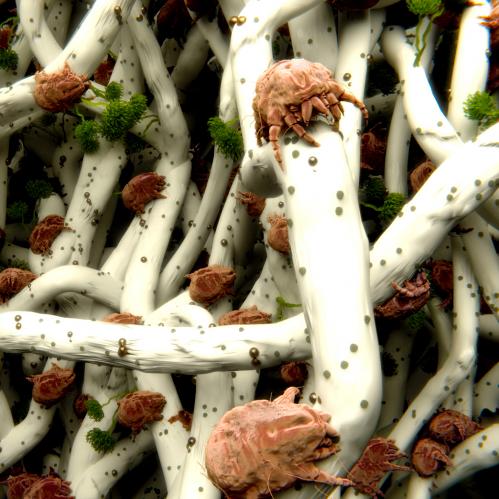
Dust Mites
People who have dust allergies are familiar with sneezing—but sneezing isn’t the only uncomfortable symptom. Dust allergies also give many people a stuffy or runny nose, or cause their eyes to itch or become red and watery.
Overview
Dust allergies also make it difficult to breathe and may trigger asthma symptoms such as wheezing, coughing, tightness in the chest and shortness of breath. Dust also just makes some people itchy. People with dust allergies often suffer the most inside their own homes or in other people’s homes. Oddly enough, their symptoms often worsen during or immediately after vacuuming, sweeping and dusting. The process of cleaning can stir up dust particles, making them easier to inhale.
More on Dust Mites
Dust mites. Dust mites—sometimes called bed mites—are the most common cause of allergy from house dust. Dust mites live and multiply easily in warm, humid places. They prefer temperatures at or above 70 degrees Fahrenheit with humidity of 75 to 80 percent. They die when the humidity falls below 50 percent. They are not usually found in dry climates. Dust mite particles are often found in pillows, mattresses, carpeting and upholstered furniture. They float into the air when anyone vacuums, walks on a carpet or disturbs bedding and they settle once the disturbance is over.Dust mites are a common cause of asthma in children.
A house does not need to be visibly dirty to trigger a dust mite allergy reaction. The particles are too tiny to be seen and often cannot be removed using normal cleaning procedures. In fact, a vigorous cleaning can make an allergic person’s symptoms worse.
Dust Mite Allergy Symptoms
- Sneezing
- Runny or stuffy nose
- Red, itchy or teary eyes
- Wheezing, coughing, tightness in the chest and shortness of breath
- Itching
How To Rid Dust Mites
- To get rid of these tiny creatures in your home, keep in mind their living habits. They prefer temperatures of 70 F or higher and humidity of 75% to 80%. They can't survive in colder, drier places.
- In the U.S., dust mite allergies peak in July and August, when dust mite populations are high because of warm weather.
- Dust mites like to eat dead skin from pets and humans.
- You probably shed enough skin a day to feed a million dust mites.
- Flakes of dead skin in carpeting, beds, and furniture are like tasty snacks for them.
Find relief with Wool.
Remove humidity and moisture from you bed and dust mites will not plague you. Wool is the answer to dust mites. Wool reduces moisture and humidity in your bed due to it's hollow, water thirsty fiber's ability to efficiently wick away sweat. Bedding made with wool promotes dry (low humidity), comfortable warmth all evening long. (See Good Night Naturals Comforters, Mattress Pads and Pillows). On average, through perspiration and breathing, an adult can loose up to a pint of water vapor during a normal night of sleep. Menopausal women can loose even more than that! Without the proper bedding or mattress, you may be creating a dust mite factory.










